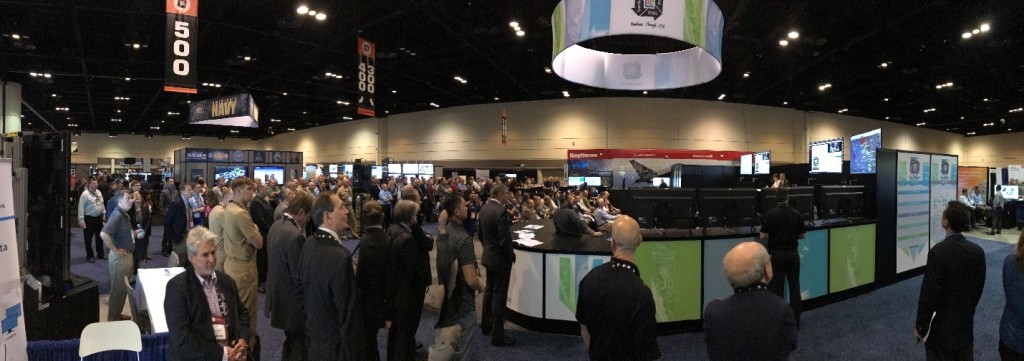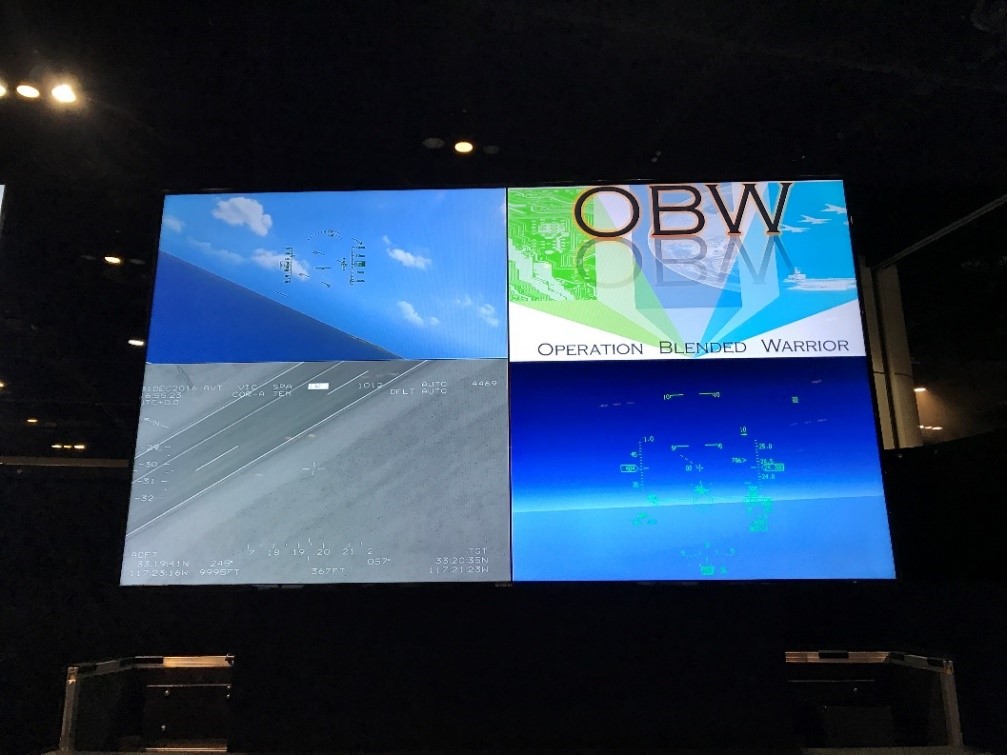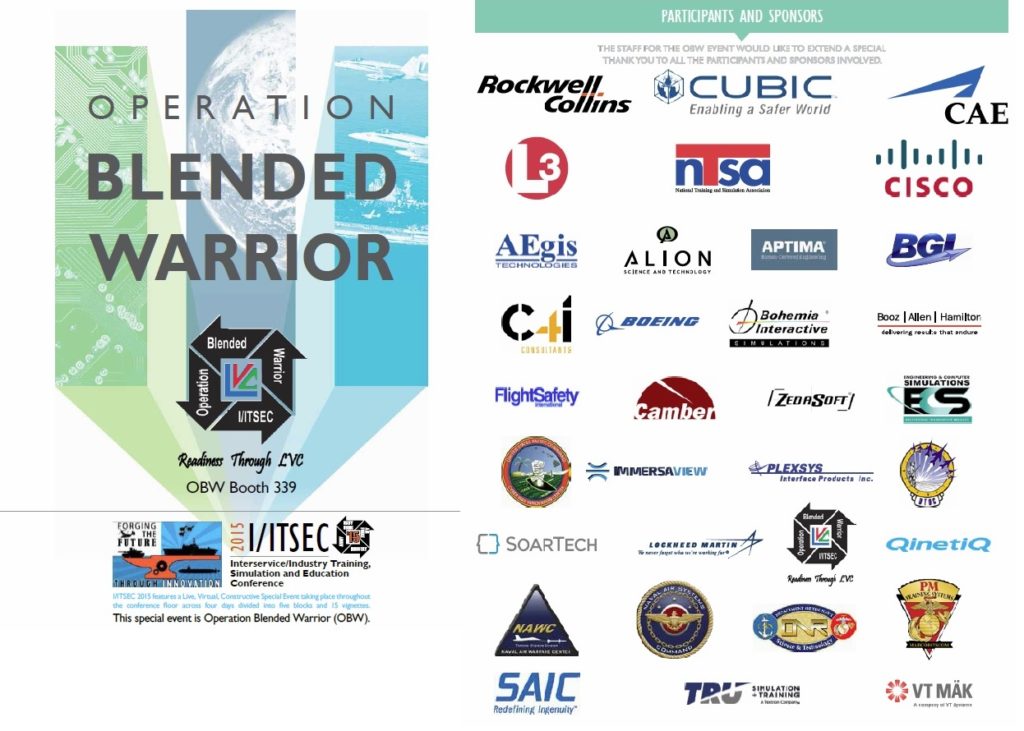
One of the premier events at Interservice/Industry Training, Simulation and Education Conference (I/ITSEC) 2015 was the Live Virtual Constructive (LVC) special exercise Operation Blended Warrior (OBW). OBW focused on developing a virtual environment for LVC simulations for training, but from the perspective of the underlying architecture and the inter-connecting systems. Announced as a multi-year annual LVC event at I/ITSEC, the National Training and Simulation Association showcased industry modeling and simulation capabilities, in conjunction with the Department of Defense modeling and simulation capabilities. A key objective of the event was to use this opportunity to collect data on the challenges that arise during the exercise. In 2015, OBW included thirty-one Industry and government participants, networked across twenty-two booths on the exhibit floor.
I/ITSEC attendees were encouraged to follow the story through numerous events across multiple days of the show. The sessions highlighted a wide variety of air, ground, maritime, medical, and cyber LVC capabilities, as well as insights into the number, degree, and priority of challenges encountered.
During OBW 2015, PLEXSYS Interface Products, Inc. (PLEXSYS) not only participated in multiple vignettes designed to highlight LVC challenges while demonstrating interoperability but also provided communications software for all OBW participants using sonomarc and PLEXCommVR. ImmersaView, A PLEXSYS company, provided Video, Audio, Data for After Action Review (VADAAR) for all participants enabling real-time video and audio streaming from all OBW booths to the viewing area. VADAAR also provided recording capability for later debriefing and After Action Review (AAR).
By 2016, OBW had grown to fifty companies and ninety disparate products and systems. The future of commercial and military simulation was stress-tested live, as multi-domains, security levels, sister-services, and foreign militaries combined into a single synthetic battlespace.
ImmersaView and PLEXSYS again played a key central role. OBW 2016 opened to International and Partner Nations. ImmersaView, as the provider of VADAAR, was involved from planning through execution, and of course, AAR. PLEXSYS participated in many demonstration events while again providing communications software to all OBW participants.
ImmersaView supported many entities across the show floor, working through connectivity and interoperability issues. PLEXSYS and ImmersaView served as the voice communications and video distribution subject matter experts to raise awareness regarding standards and AAR.

In 2017, live players were linked from three continents for the first time, including a live L-29 aircraft from Collins Aerospace – Rockwell Collins. The L-29 flew over the skies in Iowa, participating in the exercise environment representing a simulated F/A-18. By 2017, OBW included forty Industry and government participants working together across a variety of operational mission sets.
The U.S. Navy, U.S. Marine Corps, and multiple industry partners, including live military simulators from Sweden, France, and Brazil, connected to other participants on the show floor. Serious games hardware and software solutions from companies including Bohemia Interactive, CAE, Lockheed Martin, PLEXSYS/ImmersaView, and Rockwell Collins (now Raytheon Technologies) all connected and undertook LVC exercises. It was the first time this scope had been attempted live at a tradeshow.
In 2018 after three consecutive years, OBW did not take place, but NATO ran an LVC presentation for Viking 2018 at their booth. Again, ImmersaView was called to support. We sent our team of experts to support global LVC advancement.
OBW was created to exploit LVC technology to showcase issues, challenges, and solutions associated with implementing LVC capabilities into our training systems, undertaken at the World’s largest Modeling, Simulation, and Training event, I/ITSEC in Orlando. Many insights were achieved during OBW, including excellent collaboration from Industry. By leveraging the latest simulation, interoperability, and appropriately scoped visualization technologies, training cadre from all U.S. and Coalition Armed Services were able to exploit the flexibility and speed of simulation technologies to maximize the participants’ experiences in challenging and realistic environments. This interoperability solution needed to provide real-time AAR support and situational awareness from many sources was a critical factor in using VADAAR at OBW.
While there will always be a need for live training, OBW demonstrated that leveraging game-based technology for simulation and training has enormous benefits. Through lessons learned at OBW, LVC exercises play a vital role in improving training. PLEXSYS’ and ImmersaView’s products and efforts contributed to the overall success of the events. Lessons learned from the show have included continued product enhancements and the development of VADAAR-LVC.

Examples of vignettes included:
Command and Control
With regional threats to security and the need to protect relief efforts, the U.S. Military establishes an overwatch and begins to coordinate efforts of military and civilian agencies. PLEXSYS Interface Products, Inc. (2435) is providing an AWACS simulation, led the organization of assets provided by Rockwell Collins (2201), Engineering & Computer Simulations, Inc. (ECS – 1463), L-3 Communications (1449), and AEgis Technologies Group, Inc. (1901).
MEDECAV Operations
With the supply convoy trapped and taking fire, a rescue mission is mounted to retrieve casualties. Medics perform battlefield triage prior to evacuation, and field hospitals demonstrate critical care skills for the wounded. ECS (1463) led the effort and integrated their Tactical Combat Casualty Care (TC3) simulator with CAE’s (1734) Aeromedical Evacuation Training System, including human patient simulators, and convoy and air assets from Cubic (249), TRU (1101), FlightSafety International (1401) and PLEXSYS (2435).
Air-to-Air Operations
Knowing that the northern neighbor has vowed to support the militants, the U.S. sets up an exclusion zone to protect the ground operations. The wisdom of that decision is validated when several sets of attack aircraft are intercepted. This 8v8 Defensive Counter Air vignette led by NAVAIR 5.4 (439) and their Next Generation Threat System, incorporates air assets from Boeing (1700), L-3 Communications (1449), PLEXSYS (2435), Rockwell Collins (2201), SOAR (2200) and USAF DTOC (339); BGI (439) and Aptima (429) provide performance measurement capabilities.
Close Air Support Operations
Ground operations come under fire in an area too difficult to support by land. An embedded Tactical Air Control Party calls for air support, and uses a digital 9-line message to provide targeting. The effort, led by Rockwell Collins (2201), includes their own Joint Terminal Air Control simulation and various air assets from BISim (2248), Boeing (1700), L-3 Communications (1449) and PLEXSYS (2435), and ground assets from Cubic (249) and VT MÄK (827).
Hostile UAVs
In an ironic twist, unmanned vehicles launch from the north in large numbers and begin to fly towards the active operations area. Unsure whether they represent surveillance or offensive capability, manned aircraft are sent to intercept. Led by NAVAIR 5.4 (439) and their Next Generation Threat System, air assets from PLEXSYS (2435), Rockwell Collins (2201) and VT MÄK (827) integrate their systems to demonstrate this counter to an overwater threat. BGI (439) provides performance measurement.
Air-to-Air Operations
Additional air threats present themselves in an attempt to keep the U.S. forces from increasing their presence or coming ashore. The air operations center responds decisively when it learns that the UAVs and attack aircraft are focused on a nuclear storage facility along the beach near the northern border. A different look at Defensive Counter Air led by NAVAIR 5.4 (439) and their Next Generation Threat System incorporates air assets from Boeing (1700), L-3 Communications (1449), PLEXSYS (2435), Rockwell Collins (2201), SOAR (2200) and USAF DTOC (339); BGI (439) and Aptima (429) provide performance measurement capabilities.
Final Strike
With the relief effort secure, the northern neighbor bottled up and the storage facility protected, the militants are the last remaining threat to the area. A final strike is called in to eliminate the last thoroughfare from the hills, effectively ending their ability to interfere. Military offensive operations are successfully concluded. NAVAIR 5.4 (439) uses their Next Generation Threat System and teams up with Boeing (1700), Cubic (249), L-3 Communications (1449), PLEXSYS (2435), SOAR (2200) and Rockwell Collins (2201) for this Air to Ground vignette; BGI (439) and Aptima (429) provide performance measurement capabilities.